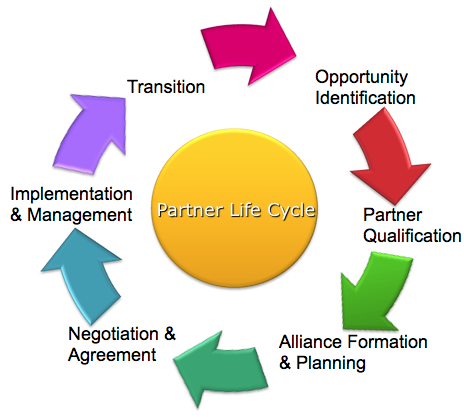 This morning I researched a couple of resources about the alliance lifecycle and noticed that the cycles I found all differ and still are somewhat similar. Quite understandable as every organization will adjust common alliance best practices to their own needs. The lifecycles I found ranged from 5 to 8 main steps. All of them obviously covering the cycle from start to transition. The differences are in most cases in the middle, where some steps are divided over more steps than others. All of them share that the alliance lifecylce is in fact an umbrella: it combines tools and substeps under the umbrella and can thus easily add up to tens of steps.
This morning I researched a couple of resources about the alliance lifecycle and noticed that the cycles I found all differ and still are somewhat similar. Quite understandable as every organization will adjust common alliance best practices to their own needs. The lifecycles I found ranged from 5 to 8 main steps. All of them obviously covering the cycle from start to transition. The differences are in most cases in the middle, where some steps are divided over more steps than others. All of them share that the alliance lifecylce is in fact an umbrella: it combines tools and substeps under the umbrella and can thus easily add up to tens of steps.
In our workshops we use the following six steps:
- Opportunity identification
- Partner qualification
- Alliance formation and planning
- Negotiation and agreement
- Implementation and management
- Transition
One of my customers uses a slightly different model where step 2 is split in two separate steps and step 3 and 4 are combined in one step. Also Cisco’s model as described in Steven Steinhilber’s book is a six step, but slightly different, lifecycle. In some cases step 3 and 4 are in a different order, putting the negotiation before the alliance formation. The 8 step process I noticed is splitting into seperate main steps some of the elements I would probably capture in substeps. This model was also different in the sense that it basically puts governance, executive sponsorship and alliance management as a continuous foundation layer below all of the steps.
In the end all lifecycles more or less follow the same structure, covering the alliance lifecycle from start till transition. How about your alliance lifecycle and processes, do they follow a similar structure or are they (radically) different?
I would agree that Negotiation should come before Alliance Formation. Why waste a whole heap of effort forming an alliance, only for it to fall apart because one of the members cannot agree terms. I would also agree that the most successul alliances are underpinned by executive sponsorship (from both sides) and continous improvement through governance/management.
Lou thanks for joining the conversation. The negotiation versus formation debate is an interesting one. What we often do is negotiate a term sheet before formation and negotiate the actual contract after or during the formation phase. That phase will shed more light on the elements that need to be negotiated and sometimes these steps need to go hand in hand.
Agree completely with you on executive sponsorship; it needs to be on board early on in step 1 already and continuously throughout the alliance (also through a clear governance structure) else an alliances is often doomed to fail.
I developed the global partner recruitment process for SAP in 2005, and it was indeed very consistent with the framework above. A key dimension that is missing though is somehow the capacity planning and white space analysis i.e., from a vendor point of view, where do i need resellers and / or service partners, in which industries, etc … It may sound trivial but is actually the foundation of proper partner revruitment … And hence of succesful win-win partnerships.
Xavier, thanks for your comment and pointing to the missing item. I agree with the importance of the steps you mentioned, for me they are integral part of step 1: “opportunity identification”. Would you prefer to make separate steps for these actions?
My experience is that the exact number of steps (be it six or eight) or the exact names of the steps (transition or implementation) are not as important as the work that supports the identification, development, implementation, and ongoing management of the alliance.
Thanks Craig, agree the number of steps might be irrelevant, it is more about the process and the fact that is really been thought about laying a proper foundation for a future partnership.
Thanks Craig, agree the number of steps might be irrelevant, it is more about the process and the fact that is really been thought about laying a proper foundation for a future partnership.